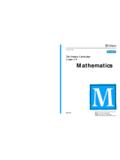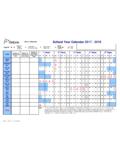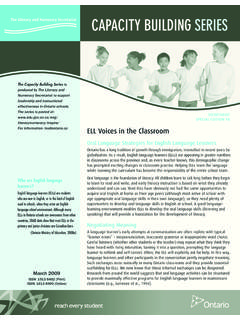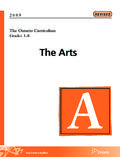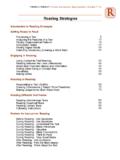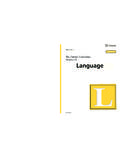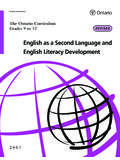Transcription of The Ontario Curriculum - Ministry of Education
1 Mathematics2007 Ministry of EducationThe Ontario CurriculumGrades 11 and 12 REVISED INTRODUCTION3 Secondary Schools for the Twenty-first Century ..3 The Importance of Mathematics in the Curriculum ..3 Roles and Responsibilities in Mathematics Programs ..5 THE PROGRAM IN MATHEMATICS7 Overview of the Program ..7 Curriculum Expectations ..11 Courses and Strands ..12 THE MATHEMATICAL PROCESSES17 Problem Solving ..18 Reasoning and Proving ..19 Reflecting ..19 Selecting Tools and Computational Strategies ..19 Connecting ..21 Representing ..21 Communicating ..22 ASSESSMENT AND EVALUATION OF STUDENT ACHIEVEMENT23 Basic Considerations ..23 The Achievement Chart for Mathematics ..25 Evaluation and Reporting of Student Achievement ..26 Reporting on Demonstrated Learning Skills ..27 SOME CONSIDERATIONS FOR PROGRAM PLANNING IN MATHEMATICS30 Instructional Approaches ..30 Planning Mathematics Programs for Students With Special Education Needs.
2 32 Program Considerations for English Language Learners ..34 CONTENTSUne publication quivalente est disponible en fran ais sous le titre suivant : Le Curriculum de l Ontario , 11eet 12eann e Math matiques, publication is available on the Ministry of Education swebsite, at Education in Mathematics ..35 Literacy and Inquiry/Research Skills ..36 The Role of Information and Communication Technology in Mathematics ..37 Career Education in Mathematics ..37 The Ontario Skills Passport and Essential Skills ..38 Cooperative Education and Other Forms of Experiential Learning ..38 Planning Program Pathways and Programs Leading to a Specialist High-Skills Major ..39 Health and Safety in Mathematics ..39 COURSES41 grade 11 Functions, University Preparation (MCR3U) ..43 Functions and Applications, University/College Preparation (MCF3M) ..57 Foundations for College Mathematics, College Preparation (MBF3C) ..67 Mathematics for Work and Everyday Life, Workplace Preparation (MEL3E).
3 77 grade 12 Advanced Functions, University Preparation (MHF4U) ..85 Calculus and Vectors, University Preparation (MCV4U) ..99 Mathematics of Data Management, University Preparation (MDM4U) ..111 Mathematics for College Technology, College Preparation (MCT4C) ..123 Foundations for College Mathematics, College Preparation (MAP4C) ..135 Mathematics for Work and Everyday Life, Workplace Preparation (MEL4E) ..147 INTRODUCTIONThis document replaces The Ontario Curriculum , grade 11: Mathematics, 2006, and theGrade 12 courses inThe Ontario Curriculum , grades 11 and 12: Mathematics, in September 2007, all grade 11 and grade 12 mathematics courses will bebased on the expectations outlined in this SCHOOLS FOR THE TWENTY-FIRST CENTURYThe goal of Ontario secondary schools is to support high-quality learning while givingindividual students the opportunity to choose programs that suit their skills and updated Ontario Curriculum , in combination with a broader range of learningoptions outside traditional classroom instruction.
4 Will enable students to better customizetheir high school Education and improve their prospects for success in school and in IMPORTANCE OF MATHEMATICS IN THE CURRICULUMThis document provides a framework outlining what students are expected to know andbe able to do by the end of each of the courses in the grade 11 12 mathematics required knowledge and skills include not only important mathematical facts andprocedures but also the mathematical concepts students need to understand and themathematical processes they must learn to principles underlying this Curriculum are shared by educators dedicated to the successof all students in learning mathematics. Those principles can be stated as follows:1 Curriculum expectations must be coherent, focused, and well-articulated across the mathematics involves the meaningful acquisition of concepts, skills, andprocesses and the active involvement of students in building new knowledge fromprior knowledge and tools such as manipulatives and technologies are important supports forteaching and learning teaching of mathematics requires that the teacher understand the mathe- matical concepts, procedures, and processes that students need to learn, and use avariety of instructional strategies to support meaningful and evaluation must support learning, recognizing that students learnand demonstrate learning in various Adapted from Principles and Standards for School Mathematics, developed by the National Council of Teachers ofMathematics (Reston, VA: NCTM, 2000).
5 Equity of opportunity for student success in mathematics involves meeting thediverse learning needs of students and promoting excellence for all is achieved when Curriculum expectations are grade - and destination-appropriate, when teaching and learning strategies meet a broad range of studentneeds, and when a variety of pathways through the mathematics Curriculum aremade available to Ontario mathematics Curriculum must serve a number of purposes. It must engageall students in mathematics and equip them to thrive in a society where mathematics isincreasingly relevant in the workplace. It must engage and motivate as broad a group of students as possible, because early abandonment of the study of mathematics cuts students off from many career paths and postsecondary options. The unprecedented changes that are taking place in today s world will profoundly affectthe future of today s students. To meet the demands of the world in which they live, stu-dents will need to adapt to changing conditions and to learn independently.
6 They willrequire the ability to use technology effectively and the skills for processing large amountsof quantitative information. Today s mathematics Curriculum must prepare students fortheir future roles in society. It must equip them with an understanding of importantmathematical ideas; essential mathematical knowledge and skills; skills of reasoning,problem solving, and communication; and, most importantly, the ability and the incen-tive to continue learning on their own. This Curriculum provides a framework foraccomplishing these development of mathematical knowledge is a gradual process. A coherent and con-tinuous program is necessary to help students see the big pictures , or underlying prin-ciples, of mathematics. The fundamentals of important skills, concepts, processes, andattitudes are initiated in the primary grades and fostered throughout elementary links between grade 8 and grade 9 and the transition from elementary school mathe-matics to secondary school mathematics are very important in developing the student sconfidence and secondary courses are based on principles that are consistent with those that under-pin the elementary program, facilitating the transition from elementary school.
7 Thesecourses reflect the belief that students learn mathematics effectively when they are givenopportunities to investigate new ideas and concepts, make connections between newlearning and prior knowledge, and develop an understanding of the abstract mathematicsinvolved. Skill acquisition is an important part of the learning; skills are embedded in the contexts offered by various topics in the mathematics program and should be introduced as they are needed. The mathematics courses in this Curriculum recognize theimportance of not only focusing on content, but also of developing the thinking processesthat underlie mathematics. By studying mathematics, students learn how to reason logi-cally, think critically, and solve problems key skills for success in today s workplaces. Mathematical knowledge becomes meaningful and powerful in application. This curri-culum embeds the learning of mathematics in the solving of problems based on real-lifesituations.
8 Other disciplines are a ready source of effective contexts for the study of mathe-matics. Rich problem-solving situations can be drawn from related disciplines, such ascomputer science, business, recreation, tourism, biology , physics, and technology, as well as from subjects historically thought of as distant from mathematics, such as geographyTHE Ontario Curriculum , grades 11 and 12|Mathematics4and art. It is important that these links between disciplines be carefully explored, analysed,and discussed to emphasize for students the pervasiveness of mathematical concepts andmathematical thinking in all subject choice of specific concepts and skills to be taught must take into consideration newapplications and new ways of doing mathematics. The development of sophisticated yeteasy-to-use calculators and computers is changing the role of procedure and technique inmathematics. Operations that were an essential part of a procedures-focused curriculumfor decades can now be accomplished quickly and effectively using technology, so thatstudents can now solve problems that were previously too time-consuming to attempt,and can focus on underlying concepts.
9 In an effective mathematics program, studentslearn in the presence of technology. Technology should influence the mathematics contenttaught and how it is taught. Powerful assistive and enabling computer and handheldtechnologies should be used seamlessly in teaching, learning, and assessment. 2 This Curriculum integrates appropriate technologies into the learning and doing of mathe-matics, while recognizing the continuing importance of students mastering essentialnumeric and algebraic AND RESPONSIBILITIES IN MATHEMATICS PROGRAMSS tudentsStudents have many responsibilities with regard to their learning. Students who make the effort required to succeed in school and who are able to apply themselves will soondiscover that there is a direct relationship between this effort and their achievement, andwill therefore be more motivated to work. There will be some students, however, whowill find it more difficult to take responsibility for their learning because of special chal-lenges they face.
10 The attention, patience, and encouragement of teachers and family canbe extremely important to these students success. However, taking responsibility fortheir own progress and learning is an important part of Education for all students, regardless of their of concepts and skills in mathematics requires a sincere commitment to workand study. Students are expected to develop strategies and processes that facilitate learn-ing and understanding in mathematics. Students should also be encouraged to activelypursue opportunities to apply their problem-solving skills outside the classroom and toextend and enrich their understanding of an important role to play in supporting student learning. Studies show thatstudents perform better in school if their parents are involved in their Education . Bybecoming familiar with the Curriculum , parents can find out what is being taught in thecourses their children are taking and what their children are expected to learn.
